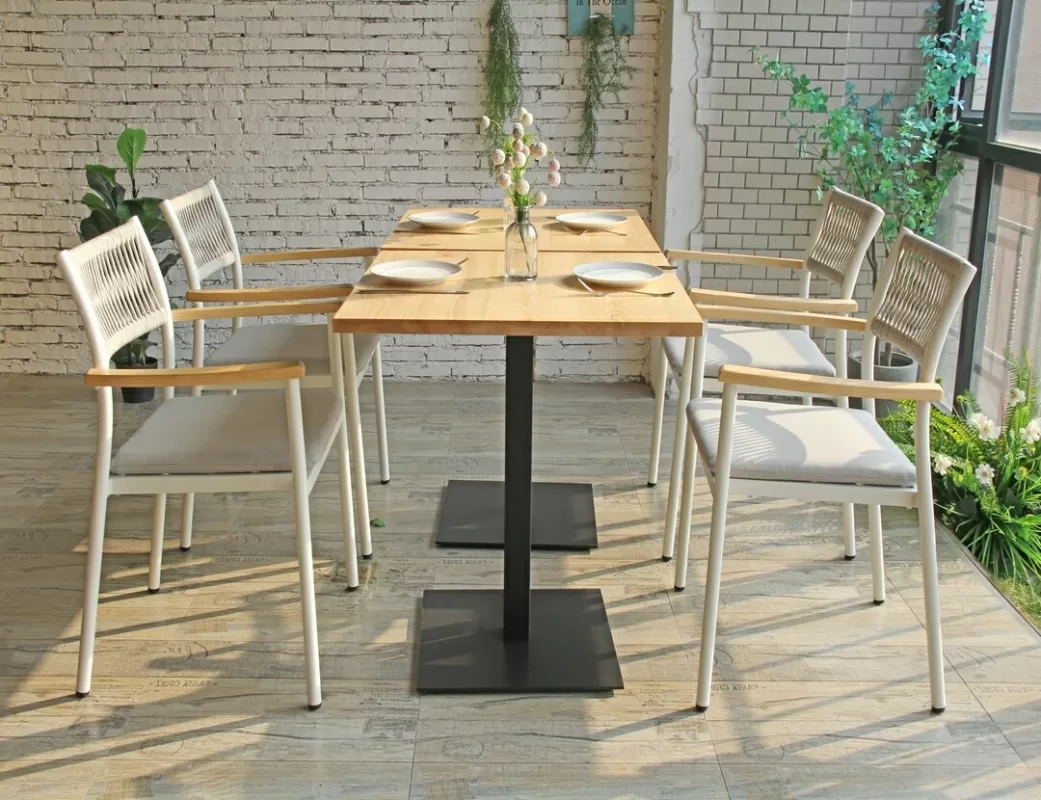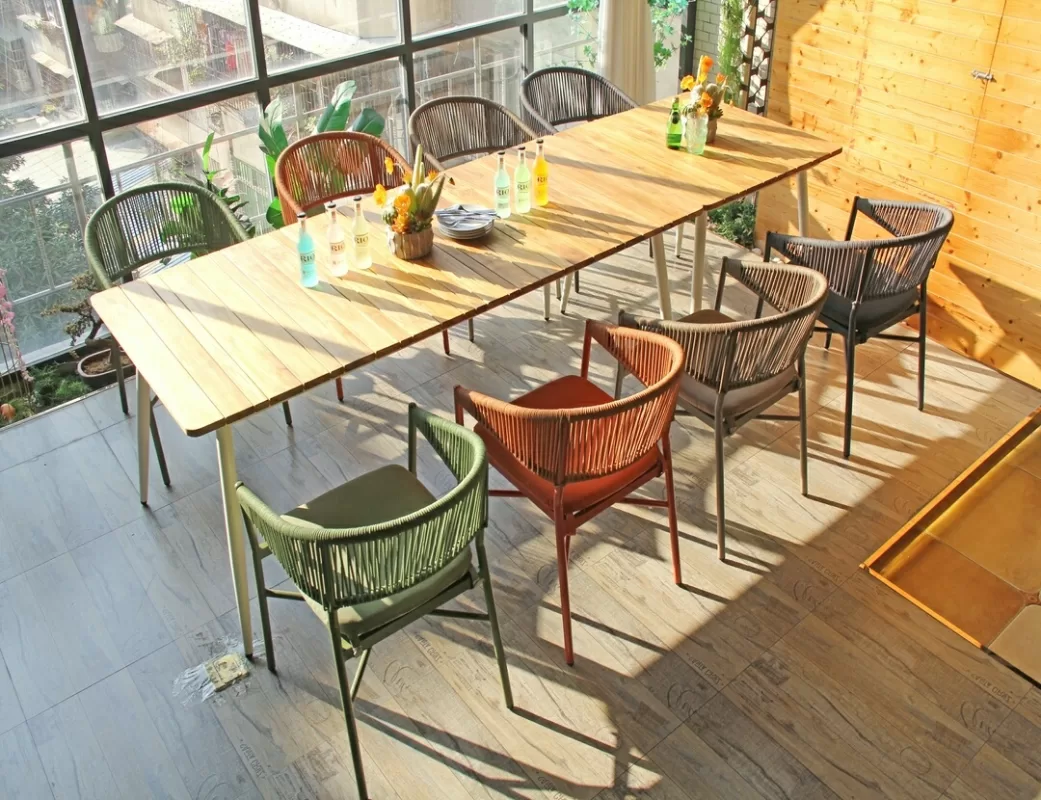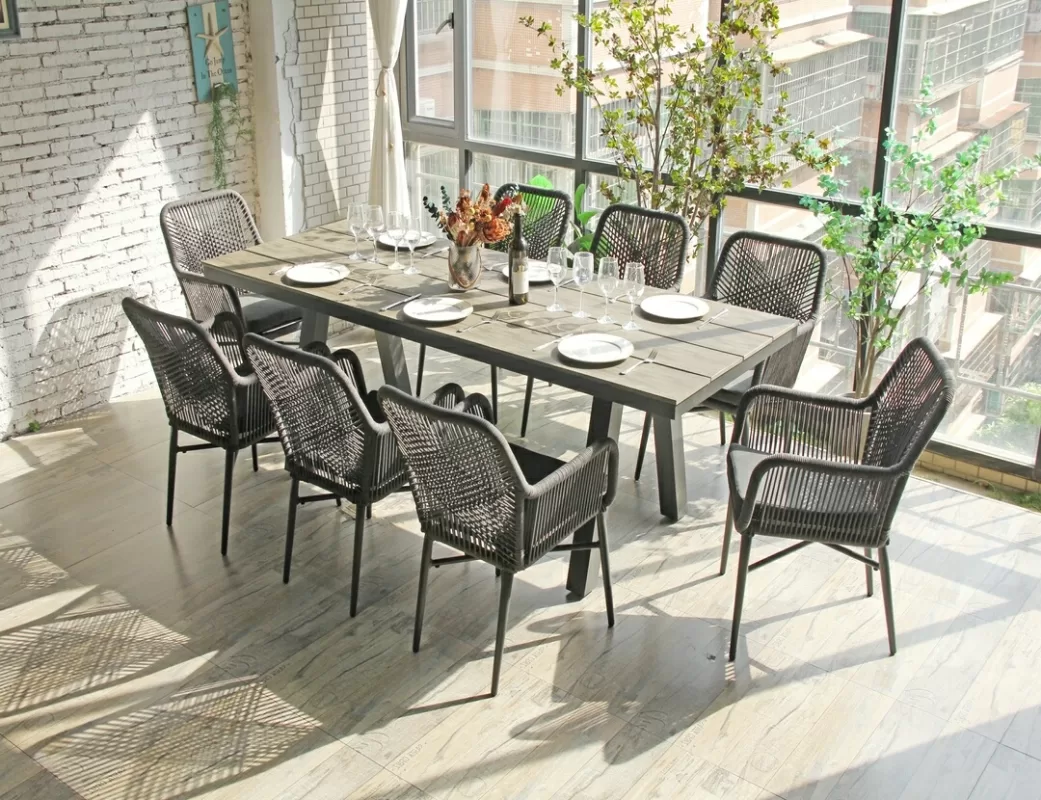- cdg01@cdgfurniture.com
- MP & WeChat & WhatsApp: +86-13926103331 (Ms. Lisa Liang)
-
![]()
-
![]()
- Home » NEWS » NEWS » Industry Information » Eye-catching Restaurant Table Tops Selecting Guides
CONTACT US
SEND INQUIRY NOWBy: CDG
Date: 04/02/2024
Email: cdg01@cdgfurniture.com
Tel: +86-20-36933270 / 36933272 / 36933273 / 36853567
MP & WeChat & WhatsApp: +86-13926103331 (Ms.Lisa Liang)
Table of Contents
Key points of Customizing Restaurant Table Tops
In the restaurant industry, restaurant decor and design are crucial to the customers' dining experience. Among them, the dining table is one of the most important elements in the restaurant, and the customization points of the dining table should be fully considered. Firstly, CDG will list the key points of customizing restaurant tables to help you create a table that is both beautiful and functional.
1. Usage scenarios and styles
When customizing a dining table, the first thing to consider is the usage scenario and overall style. Table tops of different materials are suitable for different occasions and styles. For example, solid wood table tops give people a warm and natural feeling and are suitable for cafes, theme restaurants, etc.; Marble table tops are high-end and elegant and suitable for high-end restaurants, hotels and other occasions. Therefore, when choosing the material of the tabletop, it should be determined based on the location and style of the restaurant.
2. Budget
Budget is one of the important factors that affect the customization of dining table tops. The price of dining table tops varies greatly depending on the material, quality and brand. So you need to choose the appropriate material and brand according to your budget. During the customization process, you can compare with multiple vendors to understand the market situation and ensure that you get the best quality products and services within your budget.

3. Wear-resistant and durable
The dining table top will be subject to wear and scratches during daily use, so it is necessary to choose materials with good wear resistance and durability. Materials like solid wood and marble generally have good durability and can withstand the wear and tear and scratches of everyday use. Additionally, when choosing office materials, you should also consider its dirt-repellent properties and ease of cleaning to make daily cleaning and maintenance easier.
4. Size and shape
Size and shape are one of the key factors in customizing your dining table top. When choosing the size of the tabletop, it should be determined according to the size and shape of the dining table to ensure that the tabletop matches the table frame to form a perfect overall effect. Additionally, the restaurant space layout and customers' dining needs should also be considered to ensure that the size and shape of the table top meets the actual needs of the restaurant.
5. Environmental Considerations
As people's awareness of environmental protection continues to grow, it has become common to choose environmentally friendly materials for dining tables. When choosing office materials, you should understand whether their production process and raw materials are environmentally friendly and whether harmful substances will be produced during their use. At the same time, it is also necessary to consider whether it can be recycled upon disposal to reduce the impact on the environment. When choosing a custom supplier, you should also find out whether they have the relevant environmental certifications and necessary measures to ensure that environmental protection requirements are met during production and installation.
6. Personalized merchant reputation
Choose a reputable and experienced customizer like CDG Furniture to ensure professionalism and reliability during production and installation. After choosing a custom supplier, you should also understand their production process, quality assurance, after-sales service and other information to ensure that the final custom dining table top meets the requirements.

Types of Tabletops In Commercial Restaurants
In commercial restaurants, how to chose a kind of proper tabletops is of paramount importance for customers’ dining experience and the whole style of their restaurant. With the progress of times and diversification of aesthetics, the types of restaurant tabletops have become increasingly varied. Below, we detail several common types of commercial restaurant tabletops:
1. Solid Wood Tabletops
Solid wood tabletops are favored by consumers for their natural texture and beautiful patterns, making them a common choice for high-end dining establishments. There are various types of solid wood materials, such as oak, walnut, beech, etc. Each type of wood has its unique color and texture, bringing a unique personality to the dining table. The advantages of solid wood tabletops are their naturalness, eco-friendliness, and longer lifespan. Also, solid wood tabletops have good thermal insulation properties, providing a comfortable dining environment for customers. However, solid wood tabletops require regular maintenance and care to maintain their luster and extend their lifespan.
2. Manufactured Board Tabletops
Manufactured board tabletops are an economical choice, similar in appearance and performance to solid wood countertops but at a relatively lower price. Manufactured board tabletops are usually made from wood chips, glue, and other additives, processed under high temperature and pressure. Common types include particle board and medium-density fiberboard (MDF). Due to their high flatness, wear and heat resistance, and ease of cleaning, manufactured board tabletops are widely used in small and medium-sized restaurants. However, compared to solid wood tabletops, the texture of manufactured board tabletops may seem a bit stiff.
CDG Furniture has also introduced HPL tabletops, also known as high-pressure laminate tabletops, which are gaining more attention due to their excellent performance and wide application. CDG's HPL tabletops are not only fire and water-resistant but also have good corrosion resistance, capable of resisting various chemical erosions, thereby ensuring the durability and aesthetic of the table. CDG's HPL tabletops come in a variety of colors and textures, meeting diverse decorative needs.
3. Marble Tabletops
Marble tabletops, known for their noble and elegant texture and unique patterns, have become the first choice for high-end restaurants. Common marble tabletop materials include Italian marble, Kashmir marble, etc., with various colors and textures, adding a sense of luxury to the dining table. Marble tabletops have extremely high hardness and wear resistance, can withstand high temperatures and scratches, and are easy to clean and maintain. However, marble tabletops are expensive and require careful maintenance to avoid scratches from hard objects and chemical erosion.

4. Glass Tabletops
Glass tabletops are becoming increasingly popular in modern-style restaurants, their transparent texture and minimalist style offering a fresh and bright dining experience to customers. The advantages of glass tabletops are easy cleaning, the ability to reflect light, and increasing the brightness of the space. Also, the material of glass tabletops is lightweight, not causing a sense of oppression to customers. However, safety issues with glass tabletops need attention to avoid breakage and scratches, and maintenance is also necessary.
5. Metal Tabletops
Metal tabletops are commonly used in industrial-style or modern minimalist-style restaurants, with the application of metals such as steel and aluminum alloy. The advantages of metal tabletops lie in their strong modern feel, wear resistance, heat resistance, and ease of cleaning. At the same time, the tough texture of metal tabletops can offer customers a unique dining experience. However, the temperature of metal tabletops is relatively low, which may affect the dining experience, requiring attention to insulation measures.
When choosing tabletop materials, commercial restaurants need to consider the restaurant's style, positioning, and customers' needs comprehensively. Each type of tabletop material has its unique advantages and disadvantages. Choosing the appropriate tabletop material can provide customers with a comfortable and beautiful dining environment, improving the overall quality of the restaurant. Next, we will give you some advice for selecting a proper commercial table tops.
Selection of Commercial Restaurant Table Tops
Definitely, the choice of table base has a significant impact on operational efficiency and the restaurant customer experience. Cast iron, stainless steel, aluminum and plastic are common materials for restaurant tables, each with their own advantages and disadvantages.
1. Cast iron restaurant table base
Cast iron is a durable material with high strength and stability. Cast iron table bases are generally designed to be relatively heavy, which gives a feeling of stability. Another advantage of cast iron is its fire resistance, which is very important for restaurants. However, the disadvantages of cast iron legs are also obvious, mainly due to their weight and fragility. Additionally, the maintenance cost of cast iron table base is relatively high as regular painting is required to prevent rust and corrosion.
2. Stainless steel restaurant table base
Stainless steel table legs are a beautiful and durable material with rust and corrosion resistant properties. The advantages of stainless steel table legs lie in their high strength and stability, capable of withstanding significant pressures. In addition, stainless steel table legs are easy to clean and are not easy to absorb stains, which is very convenient for restaurants. However, the cost of stainless steel legs is relatively high and they are not as fire resistant as cast iron legs.
3. Aluminum restaurant table base
Aluminum feet are light and durable, with good conductivity and thermal conductivity. The advantage of aluminum legs is their good looks and lower maintenance costs, as aluminum is less prone to rust or corrosion. However, the strength and stability of aluminum legs are not as good as those of cast iron or stainless steel legs and may undergo bending or deformation during long-term use.

4. Plastic restaurant table base
Plastic table legs are usually made from materials such as polyethylene or polypropylene, which have the advantages of being lightweight, easy to clean and inexpensive. Plastic table legs have good flexibility and can withstand certain pressure and impact forces. However, the strength and stability of plastic feet are poor, and they may be susceptible to deformation or aging due to high temperatures or ultraviolet radiation. In addition, the fire resistance of plastic table legs is not as good as that of cast iron or stainless steel table legs.
With the advancement of technology and innovation in materials, the materials for the table base s of modern restaurants are becoming increasingly diverse. Materials such as cast iron, stainless steel, aluminum, and plastic have been widely used in the catering industry due to their unique advantages. But each material has its unique characteristics and maintenance needs, therefore, the correct maintenance method is crucial for extending the service life of the table bases.
Methods For Maintaining Restaurant Table Tops
As an important part of catering, the choice of table top materials not only affects the aesthetics of the dining table, but also involves daily care and maintenance issues. Common materials for table tops include solid wood, artificial panels, marble, glass and metal, each of which has its unique characteristics and maintenance methods that require special attention.
1、Maintenance methods of solid wood table tops
Solid wood table tops have natural texture and warm tones, giving people a natural and warm feeling. However, solid wood is a natural material that is easily affected by humidity and temperature, and special care should be taken to keep it dry and avoid humid environments. In addition, one should avoid placing heat sources for a long time to avoid deformation or cracking of the wood. To maintain the shine of the solid wood top and prevent stains from penetrating, it is recommended to regularly use specialist cleaning and maintenance products for wood.

2、 Maintenance methods of artificial board table tops
Artificial board table top is a type of board made by pressing wood fibers and adhesives, which has a similar appearance and performance to solid wood. Due to their special manufacturing process, artificial board table tops have strong resistance to stains and scratches. However, due to its low surface wear resistance, scratching with sharp or heavy objects should be avoided. When cleaning daily, use a soft damp cloth to gently wipe and avoid using cleaning products containing reinforcing substances.
3、Maintenance methods of marble table tops
The marble table top has beautiful textures and hard texture, giving people a noble and elegant feeling. However, marble is a natural stone that is easily corroded by acidic substances, therefore the use of acidic cleaning products should be avoided. When cleaning daily, neutral cleaning products should be used and wiped with a damp cloth. To maintain the shine of marble and extend its lifespan, it is recommended to undergo professional polishing treatment regularly.
4、 Maintenance methods of glass table tops
The glass table top has a transparent appearance and heat resistance characteristics, giving people a modern and minimalist feeling. However, glass materials are fragile and prone to scratches. During daily use, avoid collision of heavy objects or scratches of sharp objects. When cleaning, a soft, damp cloth and a neutral cleaning agent should be used, and cleaning products containing abrasives should be avoided. To avoid cracks caused by thermal expansion and contraction, sudden cooling and heating environment should be avoided.
5、Metal table top maintenance methods
Metal table tops have a modern, high-tech look, with common materials like stainless steel and aluminum alloy. Metal materials have strong wear resistance and corrosion resistance, but prolonged or improper use may cause surface oxidation or scratches. To maintain the shine of the metal tray and extend its life, it is recommended to regularly use specialized metal cleaners for cleaning and maintenance. During daily use, it is important to avoid scratching hard objects or heavy objects.
Conclusion
We've traversed from understanding the importance of durability and material selection to recognizing the significant role aesthetics play in enhancing the dining experience. As we've seen, the choice of a table top goes beyond mere functionality; it's about creating an ambiance that resonates with the ethos of the restaurant, ensuring comfort while also standing the test of time against the rigors of daily use. The key takeaways for restaurateurs looking to make informed decisions in purchasing CDG table tops include prioritizing materials that align with their restaurant's theme and operational demands, considering the ease of maintenance and the table's ability to withstand constant use, and finally, the value of investing in designs that elevate the dining environment.
Remember, the selection of your restaurant's table tops can subtly influence the dining experience, encouraging longer stays and repeat visits. It's an investment not just in furniture but in the overall perception and success of your establishment. By choosing wisely, keeping in mind the blend of practicality, durability, and style, you can ensure that your CDG Restaurant Table Tops not only meet but exceed the expectations of your clientele, contributing significantly to the ambiance and functionality of your dining space. let your restaurant's vision guide your choice, ensuring that every element, including the table tops, reflects the quality and character of your dining experience. With the right CDG table tops, you can create a space that guests will remember fondly, eagerly returning to time and time again.
RECENT POSTS
- Must See For Restaurant Operators: How To Purchase High-Quality Restaurant Furniture At Low Cost?
- Analysis Of Color Selection Trends For Outdoor Furniture In 2025
- Design Leads The Future| CDG Furniture Perfectly Ends The 55th CIFF
- What Kind Of Bar Chair Is Suitable For An Open Bar?
- Woven Rope Chairs: Diverse Choice From Home To Commercial Space
- Which Type Of Outdoor Furniture Is More Popular In European Countries?
- Industrial Style Outdoor Furniture Modern, Simple, And Durable
- Customization And Selection Of Furniture For Themed Restaurants
- Why Aluminum Garden Furniture is the Best Choice for Outdoor Living ?
- Woven Rope Patio Furniture Set: Perfect for Every Occasion







